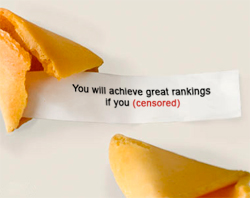Google Ranking Insights
By Kris Themstrup In E-commerce Basics, Industry News
To bring a little more transparency to their ranking philosophy and technology, Google has put together a series of posts on the Official Google Blog discussing different aspects of this mysterious algorithm and the reasoning behind it. Let’s take a look at some of the key points:
In the initial post, Udi Manber, VP of Engineering in Search Quality, put together an Introduction to Google Search Quality. He acknowledges the fact that very little is known about ranking at Google, and it’s their fault (by design). The two main reasons for this are competition and abuse. The secret recipe for ranking certainly shouldn’t be shared with competitors, and if the formula was too accessible, people would be more apt to “game the system” and manipulate the integrity of the algorithm (not that people haven’t already tried). PageRank, the most well-known part of the ranking algorithm is now referred to as part of a much larger system that includes language models, query models, time models and personalized models. The actual teams within Search Quality were also introduced, comprising of Core Ranking, International Search, User Interfaces, Evaluation, Webspam, and other teams. Udi provides a great introduction to how the Search Quality Team works and what they’re producing, but doesn’t dive to deeply into specifics on ranking, for obvious reasons.
In the second post, Amit Singhai, who’s in charge of the ranking team at Google, writes an Introduction to Google Ranking that covers the philosophy behind this system. Essentially, it consists of three main points: 1. Best locally relevant results served globally; 2. Keep it simple; 3. No manual intervention. Although these are pretty obvious in their context as part of the whole “Don’t Be Evil” mindset, Google also hints slightly at concepts brought up in the first post relating to how search results are delivered. We can assume localization is a big part of the ranking component and include that in the vague list we’ve already made, including language, query, time and personalization factors.
Finally, Amit discloses some specifics when it comes to the Technologies Behind Google Ranking. Once again, Google is careful to discuss only the advances they’ve made in certain areas rather than what factors go into the result. To fulfill the expectations of their users and continue to innovate, Google has to grasp some very complicated groups. First, they have to understand the pages, meaning they have to consider what’s implied from a page rather than just what it says. Next, they must understand queries, meaning it’s necessary to figure out what their users are looking for “beyond just the few words in their query”. The last piece of the puzzle is understanding users, or “what people really want, not just what they said in their query”. This part of the system starts in localization, goes through the personalization technology and ends up being coined “Universal Search”.
What does this all mean when marketers try and interpret these small insights from Google? First, this is nothing new. There’s no secrets spilled. As a reminder of best practices, Google refers back to the Webmaster Guidelines as default when it comes to how to perform better in search engine result pages. But we can infer that Google is moving away from a set list of criteria for rankings and including every aspect of the web in their algorithm. They stress the many filters, analysis and re-analysis search results are subjected to, depending on a variety of factors. As more people join Google and it’s many web applications, the less likely they’ll all see the same thing when performing a query.
It brings us back to when the web was originally conceived and the value of a page was determined by the community and not an algorithm. In simple terms, provide the right information, leave no marketing stone unturned, and (eventually) the rankings will follow.


No Comment